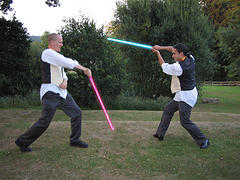I've just finished my first (and certainly not my last) reading of Robert Cialdini's book, "Influence: Science and Practice (Fifth Edition)." I must say: I'm impressed by this book.
 Influence is an interesting combination of scientific research, practical advice, and loads of case studies illustrating how humans are "hard wired" to respond to certain situations. The book provides guidance on how to use this psychological "wiring" to influence others' decisions.
Influence is an interesting combination of scientific research, practical advice, and loads of case studies illustrating how humans are "hard wired" to respond to certain situations. The book provides guidance on how to use this psychological "wiring" to influence others' decisions.
Use these powers for good
First, this book is - literally - a textbook. Cialdini presents focused chapters, followed by thought-provoking review questions and exercises that really drive the points home. Many of the examples in this book analyze well-known ploys from consumer sales, such as sneaky car sales tricks, "sweet deals" that make you feel like you've been taken after you've agreed to them, and manipulative questioning techniques.
While many of these techniques can be used for unscrupulous reasons, there are two great reasons to study them:
- They can be used for good purposes - not just bad ones.
- Once you recognize them for what they are, you can defend yourself against them. And Cialdini even tells you how to fight back when you recognize that you're being swindled by one of these manipulative tricks.
Please promise me you will not order this book if you have any plans to use these techniques for evil purposes.
Automatic responses
One of the things that makes the "tricks" studied in Influence work is a conditioned response that Cialdini describes as the "Click-Whirr Phenomenon," in which certain stimulus can trigger conditioned, "automatic" responses. Knowledge of these Click-Whirr connections is (whether they realize it or not) how most persuasive people get us to do what they want.
Some of the case studies are amusing, like this one illustrating "Reciprocation," in which a university professor sent a bunch of Christmas cards to a sample of perfect strangers:
"Although he expected some reaction, the response he received was amazing--holiday cards addressed to him came pouring back to him from people whom he had never met nor heard of him. The great majority of those who returned cards never inquired into the identity of the unknown professor. They received his holiday card, click, and whirr, they automatically sent cards in return."
Cialdini then disects the reasons Reciprocation works on us and analyzes how it can be used to get people to agree to do things for you.
Tons of mojo under the microscope
There is so much to learn from this book, in every chapter. Some things you'll learn about include:
- How the Chinese were able to influence POW's to get them to do things helpful to their Communist agenda
- How offers can be structured to make people think they are getting a special deal
- Why door-to-door solicitors always ask you for the names of others (your neighbors, relatives, etc.)
- How small commitments are used to condition people to accept larger proposals later
- The frightening power of "social proof" to get large groups of people to do what you want them to do
...and much more.
 Use the Force
Use the Force
There are some awesome techniques here that can increase the effectiveness of sales, marketing, team building, and other business disciplines when applied responsibly. If you're involved in influencing others and want to get better at it, Influence is a perfect book for you.
By the way - I wasn't joking when I requested that you only use these powers for good - don't be tempted by the dark side.
Quick side note: as I've mentioned in the past, one indicator of how much I like a book is how many times I've bought it for other people. Consider this: I've had this book about about 10 days and I've already bought copies for 5 people. Great stuff.
Picture credit: Tom Carden
Related items:
Read More I was just reading an article from Dave Crenshaw's latest newsletter about organizing your clutter around the office. It's about creating (and labeling) "homes" for all your stuff and committing yourself to stick to only putting things in their homes.
I was just reading an article from Dave Crenshaw's latest newsletter about organizing your clutter around the office. It's about creating (and labeling) "homes" for all your stuff and committing yourself to stick to only putting things in their homes.
 :
: How can you tap into the power?
How can you tap into the power?
 Use the Force
Use the Force In other words, these signs represent the most sought after categories of items in the supermarket. These tend to be the "staples of life" that are frequently listed on most people's grocery shopping lists. In fact, many of these items (such as bread, milk, eggs and, in my case, coffee) are important enough that you may go to the supermarket solely to get one of these important items.
In other words, these signs represent the most sought after categories of items in the supermarket. These tend to be the "staples of life" that are frequently listed on most people's grocery shopping lists. In fact, many of these items (such as bread, milk, eggs and, in my case, coffee) are important enough that you may go to the supermarket solely to get one of these important items.